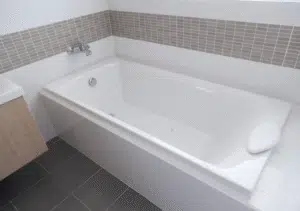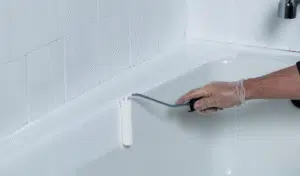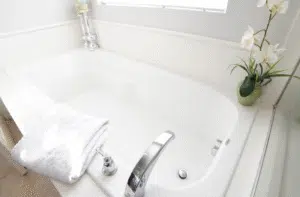Applying a clear coat to wood, paint, or other surfaces helps protect them and enhances their appearance. But over time, many people notice yellowing, especially on white or light-colored surfaces. If you’re wondering how to finish without yellowing, you’re not alone.
Yellowing can occur due to sunlight, moisture, or the use of an incorrect type of clear coat. Oil-based finishes turn yellow faster. Choosing the right product and using it correctly can prevent this and keep your project looking clean and bright.
This guide gives easy tips and shows the best clear coats to use. Whether you’re working on furniture, cabinets, or art, these steps can help. With the right tools and finish, your work will stay smooth and fresh for a long time.
Why Do Finishes Turn Yellow
Before diving into how to finish without yellowing, it’s important to understand why it happens in the first place. Yellowing occurs due to several factors:
1. UV Exposure

Sunlight is one big reason why clear finishes turn yellow. The sun’s UV rays can break down specific finishes, especially those on white or light-colored surfaces. Over time, this causes them to change and look yellow. Using a UV-blocking finish can help stop this from happening.
2. Oil-Based Formulas
Oil-based finishes, such as varnish or polyurethane, may appear clear at first, but they often turn yellow over time. This happens because the oil inside slowly changes color. If you want a finish that stays clear, it’s better to choose water-based or non-yellowing products.
3. Age and Oxidation
All finishes change slightly as they age. As the finish dries and sits over time, chemical changes can happen. These changes cause the finish to turn yellow or amber. To avoid this, pick products made to stay clear as they age.
4. Environmental Factors
Things in the air can also cause yellowing. Humidity, smoke, grease, and dust can settle on the finish and cause it to change color more quickly. Keeping the area clean, dry, and free from smoke or pollution can help your clear coat last longer and look better.
Best Finishes to Avoid Yellowing
If you want to learn how to finish without yellowing, choosing the right product is crucial. Here are the top non-yellowing finishes:
1. Water-Based Polyurethane
Water-based polyurethane is a top choice for clear, non-yellowing protection. Unlike oil-based versions, it dries clear and remains stable under UV light. It’s ideal for white furniture, light woods like maple or birch, and modern designs where clarity is key.
2. Acrylic Varnish
Acrylic varnishes are another excellent option. They resist yellowing because they lack the ambering oils found in traditional varnishes. They’re commonly used in art preservation and light-colored woodworking projects.
3. Lacquer (Nitrocellulose or Acrylic)
Lacquer provides a durable, crystal-clear finish that doesn’t yellow easily. Spray applications are typical for furniture and musical instruments. However, proper ventilation is necessary due to its strong fumes.
4. Epoxy Resin (For High-Gloss Protection)
Epoxy resin gives a thick, shiny finish that looks like glass. It’s great for tabletops and bar tops. Some epoxy types can turn yellow, but those with UV blockers remain clear for a longer period. For outdoor use, always choose a brand that offers UV protection.
5. Shellac (If Properly Sealed)
Shellac can turn yellow over time, but there’s a way to reduce it. Use a clear, blonde shellac with no wax. Then, seal it with a water-based topcoat. This helps keep the color light and stops the yellowing from showing as the finish ages.
Steps on How to Finish Without Yellowing
Now that you know the best products, let’s go through the steps to ensure a flawless, non-yellowing finish.
Step 1: Prepare the Surface Properly
To get a good finish, you must start with a clean surface. Sand the wood until it feels smooth. Wipe off all the dust using a tack cloth. Make sure there’s no oil or dirt left. Let the painted areas dry completely before proceeding.
Step 2: Use a Stain Blocker (If Needed)
Some types of wood, like oak or cherry, can cause stains to show through the finish. To stop this, use a stain-blocking primer. It helps stop yellow spots and keeps the finish looking clean and even.
Step 3: Choose the Right Finish
Choose a finish that remains clear, such as water-based polyurethane or acrylic varnish. These don’t turn yellow like oil-based ones. Think about what your project needs. Always test the finish on a scrap piece to make sure it looks right before using it.
Step 4: Apply Thin, Even Coats
Don’t use thick coats. They dry poorly and can turn yellow or crack. Instead, apply thin coats one at a time. Let each coat dry thoroughly and sand lightly in between. This gives a smooth finish that looks nice and lasts longer.
Step 5: Allow Proper Drying and Curing
Let the finish dry completely before using the item. If you rush, it can turn yellow or stay sticky. Follow the directions on the label and keep the piece away from water, heat, or cold while it dries.
Step 6: Protect from UV Light
Sunlight can make finishes turn yellow over time. Try to keep your finished item out of direct sunlight. You can use window films that block UV rays or place the item in a shaded spot to keep it looking clear and new.
What Mistakes Can Cause Yellowing
Even with the right products, mistakes in application can lead to yellowing. Here’s what to avoid:
1. Skipping a Seal Coat
When you don’t apply a seal coat, the wood can release natural oils and tannins that stain the finish. This can cause yellowing or blotchy spots. To avoid this, always seal the surface first. A proper seal helps your finish look smooth and last longer.
2. Mixing Incompatible Products
Mixing oil-based and water-based products can cause serious issues. These two types of finishes don’t blend well and can lead to yellowing, peeling, or cloudy surfaces. Always read product labels. Stick to one type of finish for the best results and long-lasting protection.
3. Poor Ventilation
Bad airflow during application can trap strong fumes and slow down drying. This affects how the finish cures and may lead to yellowing or dull spots. Always work in a space with good air circulation to help the finish dry properly and stay clear.
4. Using Old or Contaminated Finish
Old or dirty finishes can cause more harm than good. They may have thickened, gone bad, or picked up dust. Using them can lead to uneven color, yellowing, or peeling. Always check the condition of your finish before use and store it properly.
How to Keep a Clear Finish Without Yellowing Over Time
To master how to finish without yellowing, consider these pro tips:
1. Add a UV Inhibitor
Sunlight can make clear finishes turn yellow over time. To prevent this, use a UV blocker that is mixed into your finish. It helps protect the surface from sunlight damage. This is a simple way to keep wood or paint looking clear, bright, and fresh.
2. Maintain Humidity Levels
Too much moisture in the air can make finishes dry the wrong way and turn yellow faster. Try to keep your workspace dry. Use a fan or dehumidifier if needed. Keeping the area dry helps the finish last longer and look better over time.
3. Regular Cleaning
Dust and dirt in the air can accumulate and damage the finish. Clean your surfaces often using a soft, dry cloth. Stay away from strong cleaners. Light cleaning helps your finish stay clear and smooth and keeps the surface looking like new.
4. Reapply Top Coats
If you frequently use a surface, the clear coat can wear off. When that happens, yellowing can start. To stop this, add a new top coat every few years. It keeps your surface protected and looking clean, clear, and like new.
Frequently Asked Questions
How to Make a Bathtub Not Yellow?
To keep your bathtub from turning yellow, clean it regularly using baking soda and vinegar or a non-abrasive cleaner. Avoid hard water buildup and strong chemicals. Dry the tub after use to stop stains from forming. Regular care keeps your tub looking clean and white.
What Are the Alternatives to Tub Refinishing?
Alternatives to tub refinishing include using a bathtub liner, replacing the tub, or deep cleaning with stain removers. Liners cover old surfaces, while new tubs offer a full upgrade. Deep cleaning is cheaper but doesn’t fix chips or cracks like refinishing or replacing does.
Why Do Bathtubs Turn Yellow?
Bathtubs turn yellow because of hard water, soap scum, or iron and mineral stains. Over time, these build up and leave behind yellow marks. Some cleaners or old finishes can also cause discoloration. Regular cleaning and soft water help stop yellow stains from forming.
What Is the Best Product to Resurface a Bathtub?
The best product to resurface a bathtub is an epoxy or acrylic refinishing kit. These give a smooth, white finish and help cover stains and cracks. Look for kits made for tubs and follow directions carefully. A good kit makes old tubs look new again.
What Not to Use on a Resurfaced Tub?
Do not use harsh cleaners, bleach, or abrasive scrub pads on a resurfaced tub. These can scratch or wear down the new finish. Instead, use soft cloths and mild soap. Taking care of the surface helps your tub stay smooth and shiny longer.
Conclusion
Making your wood or painted surfaces look clean and new is easier than you might think. Yellowing occurs when the incorrect finish is applied or when sunlight and moisture cause damage. By using the right products and steps, you can stop yellowing before it starts.
Learning how to finish without yellowing helps keep your project looking bright and fresh. Whether you're working on furniture, cabinets, or artwork, small choices make a big difference. A good, clear coat and a little care go a long way in keeping your work smooth and pleasant for many years.
Fort Worth Refinishing is one of the best refinishing contractors in Fort Worth, TX. We offer expert refinishing services that Fort Worth homeowners trust. We treat your project as if it were our own. Call us at (817) 633-9100 today and get the smooth, clean finish your project deserves.
End Note
Fort Worth Refinishing offers expert refinishing services that restore the beauty of your bathtub without requiring a full replacement. Our bathtub refinishing process is affordable, quick, and long-lasting. Visit our site to see how we can improve your bathroom in just one day.
Learn more about our team on the About Us and Our Philosophy pages. We offer trusted service and quality work. We proudly serve many nearby areas. Visit our Areas We Serve page and explore real project results in our gallery.
Stay connected with us on Facebook and YouTube, where we post tips, updates, and customer stories. If you’re ready to start, just fill out our easy contact form to ask questions or request a free quote. Fort Worth Refinishing is here to help you enjoy a fresh, clean space.
Fort Worth Refinishing
2627 S Cooper St Suite E12, Arlington, TX 76015, United States
+18176339100



